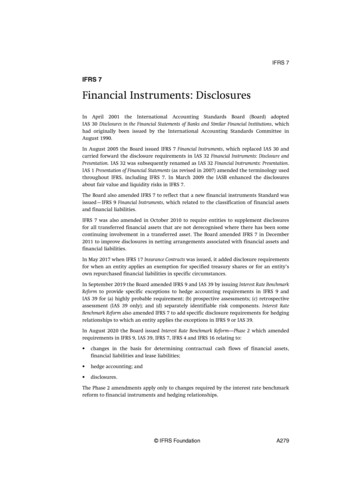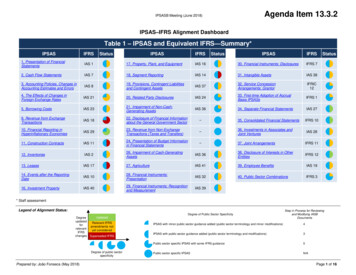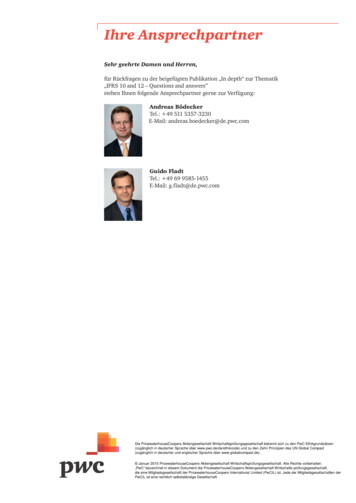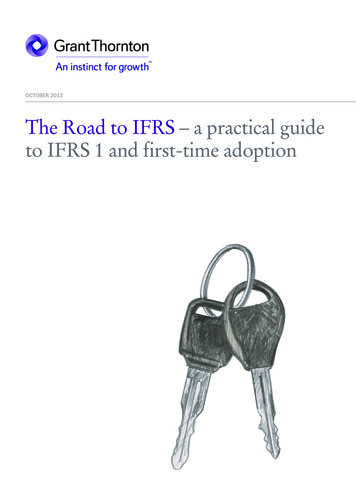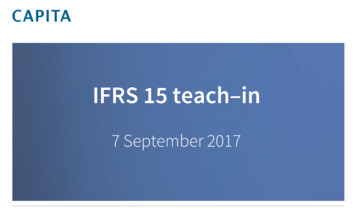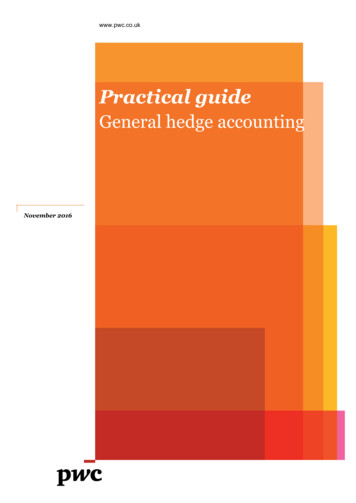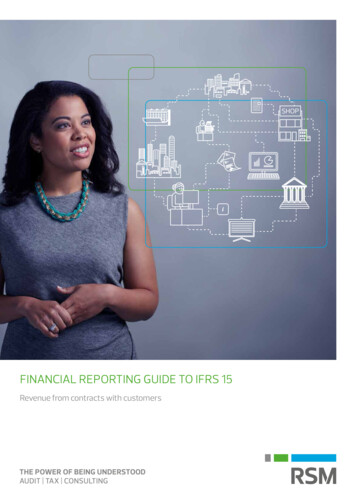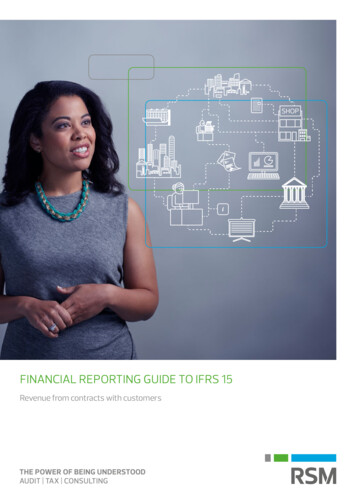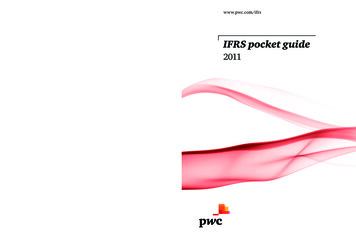
Transcription
IFRS pocket guide 2011www.pwc.com/ifrsFSCISBNwww.pwc.com/ifrsIFRS pocket guide2011
IntroductionIntroductionThis pocket guide provides a summary of the recognition and measurementrequirements of International Financial Reporting Standards (IFRS) issued upto August 2011. It does not address in detail the disclosure requirements; thesecan be found in the PwC publication ‘IFRS disclosure checklist 2011’.The information in this guide is arranged in six sections: Accounting principles. Income statement and related notes. Balance sheet and related notes. Consolidated and separate financial statements. Other subjects. Industry-specific topics.More detailed guidance and information on these topics can be found in the‘IFRS manual of accounting 2012’ and other PwC publications. A list of PwC’sIFRS publications is provided on the inside front and back covers.IFRS pocket guide 2011
ContentsContentsAccounting rules and ctionAccounting principles and applicability of IFRSFirst-time adoption of IFRS – IFRS 1Presentation of financial statements – IAS 1Accounting policies, accounting estimates and errors – IAS 8Financial instruments – IFRS 9, IFRS 7, IAS 32, IAS 39Foreign currencies – IAS 21, IAS 29Insurance contracts – IFRS 4Revenue – IAS 18, IAS 11, IAS 20Segment reporting – IFRS 8Employee benefits – IAS 19Share-based payment – IFRS 2Taxation – IAS 12Earnings per share – IAS 3311123681718192122252628Balance sheet and related 38iIntangible assets – IAS 38Property, plant and equipment – IAS 16Investment property – IAS 40Impairment of assets – IAS 36Lease accounting – IAS 17Inventories – IAS 2Provisions and contingences – IAS 37Events after the reporting period and financial commitments – IAS 10Share capital and reservesIFRS pocket guide 2011
ContentsConsolidated and separate financial statements4024. Consolidated and separate financial statements – IAS 2724A. Consolidated financial statements – IFRS 1025. Business combinations – IFRS 326. Disposals of subsidiaries, businesses and non-current assets – IFRS 527. Associates – IAS 2828. Joint ventures – IAS 3128A. Joint arrangements – IFRS 1140414244464748Other rty disclosures – IAS 24Cash flow statements – IAS 7Interim reports – IAS 34Service concession arrangements – SIC 29, IFRIC 12Retirement benefit plans – IAS 26Fair value measurement – IFRS 13Industry-specific topics5535. Agriculture – IAS 4135. Extractive industries – IFRS 65555Index by standards and interpretation57IFRS pocket guide 2011ii
Accounting rules and principlesAccounting rules and principles1 IntroductionThere have been major changes in financial reporting in recent years. Mostobvious is the continuing adoption of IFRS worldwide. Many territories havebeen using IFRS for some years, and more are planning to come on streamfrom 2012. For the latest information on countries’ transition to IFRS, visitpwc.com/usifrs and see ‘Interactive IFRS adoption by country map’.An important recent development is the extent to which IFRS is affected bypolitics. The issues with Greek debt, the problems in the banking sector andthe attempts of politicians to resolve these questions have resulted in pressureon standard-setters to amend their standards, primarily those on financialinstruments. This pressure is unlikely to disappear, at least in the short term.The IASB is working hard to respond to this; we can therefore expect acontinued stream of changes to the standards in the next few months and years.2 Accounting principles and applicability of IFRSThe IASB has the authority to set IFRSs and to approve interpretations ofthose standards.IFRSs are intended to be applied by profit-orientated entities. These entities’financial statements give information about performance, position and cashflow that is useful to a range of users in making financial decisions. Theseusers include shareholders, creditors, employees and the general public. Acomplete set of financial statements includes a: balance sheet (statement of financial position); statement of comprehensive income; statement of cash flows; a description of accounting policies; and notes to the financial statesments.Notes to the financial statements. The concepts underlying accountingpractices under IFRS are set out in the IASB’s ‘Conceptual Framework forFinancial Reporting’ issued in September 2010 (the Framework). It supersedesthe ‘Framework for the preparation and presentation of financial statements’(the Framework (1989)).IFRS pocket guide 20111
Accounting rules and principles3 First-time adoption of IFRS – IFRS 1An entity moving from national GAAP to IFRS should apply the requirementsof IFRS 1. It applies to an entity’s first IFRS financial statements and theinterim reports presented under IAS 34, ‘Interim financial reporting’, that arepart of that period. The basic requirement is for full retrospective applicationof all IFRSs effective at the reporting date. However, there are a numberof optional exemptions and mandatory exceptions to the requirement forretrospective application.The exemptions cover standards for which the IASB considers thatretrospective application could prove too difficult or could result in a costlikely to exceed any benefits to users. The exemptions are optional. Any, all ornone of the exemptions may be applied.The optional exemptions relate to: business combinations; deemed cost; employee benefits; cumulative translation differences; compound financial instruments; assets and liabilities of subsidiaries, associates and joint ventures; designation of previously recognised financial instruments; share-based payment transactions; fair value measurement of financial assets or financial liabilities atinitial recognition; insurance contracts; decommissioning liabilities included in the cost of property, plantand equipment; leases; service concession arrangements; borrowing costs; investments in subsidiaries, jointly controlled entities and associates; transfers of assets from customer; extinguishing financial liabilities with equity instruments; and severe hyperinflation.The exceptions cover areas in which retrospective application of the IFRSrequirements is considered inappropriate. The following exceptions aremandatory, not optional:2IFRS pocket guide 2011
Accounting rules and principles hedge accounting;estimates; andnon-controlling interests.Comparative information is prepared and presented on the basis of IFRS.Almost all adjustments arising from the first-time application of IFRS areagainst opening retained earnings of the first period that is presented on anIFRS basis.Certain reconciliations from previous GAAP to IFRS are also required.4 Presentation of financial statements – IAS 1The objective of financial statements is to provide information that is usefulin making economic decisions. IAS 1’s objective is to ensure comparability ofpresentation of that information with the entity’s financial statements ofprevious periods and with the financial statements of other entities.Financial statements are prepared on a going concern basis unless managementintends either to liquidate the entity or to cease trading, or has no realisticalternative but to do so. Management prepares its financial statements, exceptfor cash flow information, under the accrual basis of accounting.There is no prescribed format for the financial statements. However, thereare minimum disclosures to be made in the primary statements and thenotes. The implementation guidance to IAS 1 contains illustrative examplesof acceptable formats.Financial statements disclose corresponding information for the precedingperiod (comparatives) unless a standard or interpretation permits orrequires otherwise.Statement of financial position (balance sheet)The statement of financial position presents an entity’s financial position at aspecific point in time. Subject to meeting certain minimum presentation anddisclosure requirements, management may use its judgement regarding theform of presentation, such as whether to use a vertical or a horizontal format,which sub-classifications to present and which information to disclose in theprimary statement or in the notes.IFRS pocket guide 20113
Accounting rules and principlesThe following items, as a minimum, are presented on the face of thebalance sheet: Assets – property, plant and equipment; investment property;intangible assets; financial assets; investments accounted for usingthe equity method; biological assets; deferred tax assets; current taxassets; inventories; trade and other receivables; and cash and cashequivalents. Equity – issued capital and reserves attributable to the parent’sowners; and non-controlling interest. Liabilities – deferred tax liabilities; current tax liabilities; financialliabilities; provisions; and trade and other payables. Assets and liabilities held for sale – the total of assets classified asheld for sale and assets included in disposal groups classified as heldfor sale; and liabilities included in disposal groups classified as heldfor sale in accordance with IFRS 5, ‘Non-current assets held for saleand discontinued operations’.Current and non-current assets and current and non-current liabilities arepresented as separate classifications in the statement unless presentationbased on liquidity provides information that is reliable and more relevant.Statement of comprehensive incomeThe statement of comprehensive income presents an entity’s performance overa specific period. Entities have a choice of presenting this in a single statementor as two statements. The statement of comprehensive income under thesingle-statement approach includes all items of income and expense andincludes each component of other comprehensive income. Under the twostatement approach, all components of profit or loss are presented in anincome statement, followed immediately by a statement of comprehensiveincome. This begins with the total profit or loss for the period, displays allcomponents of other comprehensive income and ends with totalcomprehensive income for the period.Items to be presented in statement of comprehensive incomeThe following items, as a minimum, are presented in the statement ofcomprehensive income: revenue; finance costs;4IFRS pocket guide 2011
Accounting rules and principles share of the profit or loss of associates and joint ventures accounted forusing the equity method;tax expense;post-tax profit or loss of discontinued operations aggregated with anypost-tax gain or loss recognised on the measurement to fair value lesscosts to sell (or on the disposal) of the assets or disposal group(s)constituting the discontinued operation.profit or loss for the period;each component of other comprehensive income classified by nature;share of the other comprehensive income of associates and jointventures accounted for using the equity method; andtotal comprehensive income.Profit or loss for the period and total comprehensive income are allocated inthe statement of comprehensive income to the amounts attributable to noncontrolling interest and to the parent’s owners.Additional line items and sub-headings are presented in this statementwhen such presentation is relevant to an understanding of the entity’sfinancial performance.Material itemsThe nature and amount of items of income and expense are disclosedseparately, where they are material. Disclosure may be in the statement orin the notes. Such income/expenses might include restructuring costs;write-downs of inventories or property, plant and equipment; litigationsettlements; and gains or losses on disposals of non-current assets.Other comprehensive incomeAn entity presents each component of other comprehensive income in thestatement either (a) net of its related tax effects, or (b) before its related taxeffects, with the aggregate tax effect of these components shown separately.The IASB issued ‘Presentation of items of other comprehensive income(Amendments to IAS 1)’ in June 2011. This requires items of othercomprehensive income to be grouped into those that will be reclassifiedsubsequently to profit or loss and those that will not be reclassified. Theamendment is effective for annual periods beginning on or after 1 July 2012.Earlier application is permitted; it is subject to EU endorsement.IFRS pocket guide 20115
Accounting rules and principlesStatement of changes in equityThe following items are presented in the statement of changes in equity: total comprehensive income for the period, showing separatelythe total amounts attributable to the parent’s owners and to noncontrolling interest; for each component of equity, the effects of retrospective application orretrospective restatement recognised in accordance with IAS 8, ‘Accounting policies, changes in accounting estimates, and errors’; and for each component of equity, a reconciliation between the carryingamount at the beginning and the end of the period, separatelydisclosing changes resulting from: profit or loss; other comprehensive income; and transactions with owners in their capacity as owners, showingseparately contributions by and distributions to owners andchanges in ownership interests in subsidiaries that do not resultin a loss of control.Statement of cash flowsCash flow statements are addressed in Section 30 dealing with therequirements of IAS 7.Notes to the financial statementsThe notes are an integral part of the financial statements. Notes provideinformation additional to the amounts disclosed in the ‘primary’statements. They include accounting policies and critical accountingestimates and judgements.5 Accounting policies, accounting estimates and errors – IAS 8An entity follows the accounting policies required by IFRS that are relevantto the particular circumstances of the entity. However, for some situations,standards offer a choice; there are other situations where no guidance isgiven by IFRSs. In these situations, management should select appropriateaccounting policies.6IFRS pocket guide 2011
Accounting rules and principlesManagement uses its judgement in developing and applying an accountingpolicy that results in information that is relevant and reliable. Reliableinformation demonstrates the following qualities: faithful representation,substance over form, neutrality, prudence and completeness. If there is no IFRSstandard or interpretation that is specifically applicable, management shouldconsider the applicability of the requirements in IFRS on similar and relatedissues, and then the definitions, recognition criteria and measurement conceptsfor assets, liabilities, income and expenses in the Framework. Managementmay also consider the most recent pronouncements of other standard-settingbodies, other accounting literature and accepted industry practices, wherethese do not conflict with IFRS.Accounting policies should be applied consistently to similar transactionsand events.Changes in accounting policiesChanges in accounting policies made on adoption of a new standard areaccounted for in accordance with the transition provisions (if any) within thatstandard. If specific transition provisions do not exist, a change in policy(whether required or voluntary) is accounted for retrospectively (that is, byrestating all comparative figures presented) unless this is impracticable.Issue of new/revised standards not yet effectiveStandards are normally published in advance of the required implementationdate. In the intervening period, where a new/revised standard that is relevantto an entity has been issued but is not yet effective, management discloses thisfact. It also provides the known or reasonably estimable information relevantto assessing the impact that the application of the standard might have on theentity’s financial statements in the period of initial recognition.Changes in accounting estimatesAn entity recognises prospectively changes in accounting estimates byincluding the effects in profit or loss in the period that is affected (the periodof the change and future periods), except if the change in estimate gives riseto changes in assets, liabilities or equity. In this case, it is recognised byadjusting the carrying amount of the related asset, liability or equity in theperiod of the change.IFRS pocket guide 20117
Accounting rules and principlesErrorsErrors may arise from mistakes and oversights or misinterpretation ofinformation. Errors that are discovered in a subsequent period are prior-perioderrors. Material prior-period errors are adjusted retrospectively (that is, byrestating comparative figures) unless this is impracticable.6 Financial instruments – IFRS 9, IFRS 7, IAS 32, IAS 39Objectives and scopeFinancial instruments are addressed in these standards: IFRS 7, ‘Financial instruments: Disclosure’, IAS 32, ‘Financial instruments: Presentation’, which deals withdistinguishing debt from equity and with netting; and IAS 39, ‘Financial instruments: Recognition and measurement’.The objective of the standards is to establish requirements for all aspectsof accounting for financial instruments, including distinguishing debt fromequity, netting, recognition, derecognition, measurement, hedge accountingand disclosure.The standards’ scopes are broad. The standards cover all types of financialinstrument, including receivables, payables, investments in bonds and shares,borrowings and derivatives. They also apply to certain contracts to buy or sellnon-financial assets (such as commodities) that can be net-settled in cash oranother financial instrument.In November 2009, the IASB published the first part of its three-stageproject to replace IAS 39, in the form of a new standard IFRS 9, ‘Financialinstruments’. This first phase deals with the classification andmeasurement of financial assets. The standard applies for annual periodsbeginning on or after 1 January 2013. Early application is permitted; it issubject to EU endorsement.IFRS 9 replaces the multiple classification and measurement models in IAS 39with a single model that has only two classification categories: amortised costand fair value. Classification under IFRS 9 is driven by the entity’s businessmodel for managing the financial assets and the contractual characteristics ofthe financial assets.8IFRS pocket guide 2011
Accounting rules and principlesA financial asset is measured at amortised cost if two criteria are met: The objective of the business model is to hold the financial asset for thecollection of the contractual cash flows; and The contractual cash flows under the instrument solely represent paymentsof principal and interest.IFRS 9 removes the requirement to separate embedded derivatives fromfinancial asset hosts. It requires a hybrid contract to be classified in its entiretyat either amortised cost or fair value.Two of the existing three fair value option criteria become obsolete underIFRS 9, as a fair value driven business model requires fair value accounting,and hybrid contracts are classified in their entirety at fair value. Theremaining fair value option condition in IAS 39 is carried forward to the newstandard – that is, management may still designate a financial asset as at fairvalue through profit or loss on initial recognition if this significantly reduces anaccounting mismatch. The designation at fair value through profit or loss willcontinue to be irrevocable.IFRS 9 prohibits reclassifications except in rare circumstances when the entity’sbusiness model changes.There is specific guidance for contractually linked instruments that createconcentrations of credit risk, which is often the case with investment tranchesin a securitisation.IFRS 9’s classification principles indicate that all equity investments shouldbe measured at fair value. However, management has an option to presentin other comprehensive income unrealised and realised fair value gains andlosses on equity investments that are not held for trading.IFRS 9 removes the cost exemption for unquoted equities and derivatives onunquoted equities but provides guidance on when cost may be anappropriate estimate of fair value.In October 2010, the IASB published additions to the first part of IFRS 9 onthe classification and measurement of financial liabilities. The additions retainmost of the IAS 39 requirements. These include amortised cost accounting formost financial liabilities, with bifurcation of embedded derivatives. The mainchange in the additions is that in cases where the fair value option is takenIFRS pocket guide 20119
Accounting rules and principlesfor financial liabilities, the part of a fair value change due to an entity’s owncredit risk is recorded in other comprehensive income rather than the incomestatement, unless this creates an accounting mismatch. This change willmainly affect financial institutions.In August 2011, the IASB issued an exposure draft that proposes to delay theeffective date of IFRS 9 to annual periods beginning on or after 1 January2015 and permits earlier adoption. The original effective date was forannual periods beginning on or after 1 January 2013, with early applicationpermitted. IFRS 9 has not yet been endorsed for use in the EU. It is the IASB’sintention for IFRS 9 ultimately to replace IAS 39 in its entirety.Nature and characteristics of financial instrumentsFinancial instruments include a wide range of assets and liabilities, such astrade debtors, trade creditors, loans, finance lease receivables andderivatives. They are recognised and measured according to IAS 39’srequirements and are disclosed in accordance with IFRS 7.Financial instruments represent contractual rights or obligations to receive orpay cash or other financial assets. Non-financial items have a more indirect,non-contractual relationship to future cash flows.A financial asset is cash; a contractual right to receive cash or anotherfinancial asset; a contractual right to exchange financial assets or liabilitieswith another entity under conditions that are potentially favourable; or anequity instrument of another entity.A financial liability is a contractual obligation to deliver cash or anotherfinancial asset; or to exchange financial instruments with another entity underconditions that are potentially unfavourable.An equity instrument is any contract that evidences a residual interest in theentity’s assets after deducting all of its liabilities.A derivative is a financial instrument that derives its value from an underlyingprice or index; requires little or no initial net investment; and is settled at afuture date.10IFRS pocket guide 2011
Accounting rules and principlesEmbedded derivatives in host contractsSome financial instruments and other contracts combine a derivative anda non-derivative in a single contract. The derivative part of the contract isreferred to as an ‘embedded derivative’. Its effect is that some of the contract’scash flows vary in a similar way to a stand-alone derivative. For example, theprincipal amount of a bond may vary with changes in a stock market index. Inthis case, the embedded derivative is an equity derivative on the relevant stockmarket index.Embedded derivatives that are not ‘closely related’ to the rest of the contractare separated and accounted for as stand-alone derivatives (that is, measuredat fair value, generally with changes in fair value recognised in profit or loss).An embedded derivative is not ‘closely related’ if its economic characteristicsand risks are different from those of the rest of the contract. IAS 39 sets outmany examples to help determine when this test is (and is not) met.Analysing contracts for potential embedded derivatives is one of the morechallenging aspects of IAS 39.Classification of financial instrumentsThe way that financial instruments are classified under IAS 39 drives howthey are subsequently measured and where changes in measurement areaccounted for.Under financial instruments accounting, prior to the impact of IFRS 9, thereare four classes of financial asset (under IAS 39): fair value through profit orloss, held to maturity, loans and receivables and available for sale. The factorsto take into account when classifying financial assets include: Are the cash flows arising from the instrument fixed or determinable? Doesthe instrument have a maturity date? Are the assets held for trading? Does management intend to hold theinstruments to maturity? Is the instrument a derivative, or does it contain an embedded derivative? Is the instrument quoted on an active market? Has management designated the instrument into a particular classificationat inception?IFRS pocket guide 201111
Accounting rules and principlesFinancial liabilities are at fair value through profit or loss if they are designatedas such (subject to various conditions), if they are held for trading or if theyare derivatives (except for a derivative that is a financial guarantee contract ora designated and effective hedging instrument). They are otherwise classifiedas ‘other liabilities’.Financial assets and liabilities are measured either at fair value or at amortisedcost, depending on their classification. Changes are taken to either the incomestatement or to other comprehensive income.Reclassification of financial assets from one category to another is permittedunder limited circumstances. Various disclosures are required where areclassification has been made. Derivatives and assets designated as ‘at fairvalue through profit or loss’ under the fair value option are not eligible forthis reclassification.Financial liabilities and equityThe classification of a financial instrument by the issuer as either a liability(debt) or equity can have a significant impact on an entity’s gearing (debtto-equity ratio) and reported earnings. It could also affect the entity’s debtcovenants.The critical feature of a liability is that under the terms of the instrument,the issuer is or can be required to deliver either cash or another financialasset to the holder; it cannot avoid this obligation. For example, a debenture,under which the issuer is required to make interest payments and redeem thedebenture for cash, is a financial liability.An instrument is classified as equity when it represents a residual interest inthe issuer’s assets after deducting all its liabilities; or, put another way, whenthe issuer has no obligation under the terms of the instrument to deliver cashor other financial assets to another entity. Ordinary shares or common stockwhere all the payments are at the discretion of the issuer are examples ofequity of the issuer.In addition, the following types of financial instrument are accounted for asequity, provided they have particular features and meet specific conditions: puttable financial instruments (for example, some shares issued by cooperative entities and some partnership interests); and12IFRS pocket guide 2011
Accounting rules and principles instruments or components of instruments that impose on the entity anobligation to deliver to another party a pro rata share of the net assetsof the entity only on liquidation (for example, some shares issued bylimited life entities).The classification of the financial instrument as either debt or equity isbased on the substance of the contractual arrangement of the instrumentrather than its legal form. This means, for example, that a redeemablepreference share, which is economically the same as a bond, is accountedfor in the same way as a bond. The redeemable preference share is thereforetreated as a liability rather than equity, even though legally it is a share ofthe issuer.Other instruments may not be as straightforward. An analysis of the termsof each instrument in the light of the detailed classification requirements isnecessary, particularly as some financial instruments contain both liabilityand equity features. Such instruments, for example bonds that are convertibleinto a fixed number of equity shares, are accounted for as separate liabilityand equity (being the option to convert) components.The treatment of interest, dividends, losses and gains in the income statementfollows the classification of the related instrument. If a preference share isclassified as a liability, its coupon is shown as interest (assuming that couponis not discretionary). However, the discretionary coupon on an instrumentthat is treated as equity is shown as a distribution.RecognitionRecognition issues for financial assets and financial liabilities tend to bestraightforward. An entity recognises a financial asset or a financial liability atthe time it becomes a party to a contract.DerecognitionDerecognition is the term used for ceasing to recognise a financial asset orfinancial liability on an entity’s balance sheet. These rules are more complex.AssetsAn entity that holds a financial asset may raise finance using the asset assecurity for the finance, or as the primary source of cash flows from which toIFRS pocket guide 201113
Accounting rules and principlesrepay the finance. The derecognition requirements of IAS 39 determinewhether the transaction is a sale of the financial assets (and therefore theentity ceases to recognise the assets) or whether finance has been secured onthe assets (and the entity recognises a liability for any proceeds received).This evaluation might be straightforward. For example, it is clear with little orno analysis that a financial asset is derecognised in an unconditional transferof it to an unconsolidated third party, with no risks and rewards of the assetbeing retained. Conversely, derecognition is not allowed where an asset hasbeen transferred but substantially all the risks and rewards of the asset havebeen retained through the terms of the agreement. However, the analysismay be more complex in other cases. Securitisation and debt factori
2. Accounting principles and applicability of IFRS 1 3. First-time adoption of IFRS - IFRS 1 2 4. Presentation of financial statements - IAS 1 3 5. Accounting policies, accounting estimates and errors - IAS 8 6 6. Financial instruments - IFRS 9, IFRS 7, IAS 32, IAS 39 8 7. Foreign currencies - IAS 21, IAS 29 17 8.
